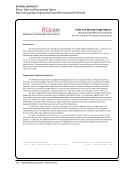188 · Representative Documents: Workflows
Yale University
Beinecke Rare Book &Manuscript Unit, Processing Manual. Electronic Files
or material relating to writing projects and correspondence (in word processing
formats). When possible, respect context and original order in arrangement. When
original order cannot be established, in general, small numbers of disks and files lend
themselves to item or file-level analysis and arrangement by content. With larger
numbers of disks and files, and disks with mixed files (e.g. writings,
correspondence, etc.), other factors will probably also need to to considered in order to
determine whether to arrange material by content or format. In baseline
processing, media may also be listed where found (disks should be housed in
Restricted Fragile).
As of December 2011, several collections containing computer media have been
processed to varying levels, providing us with some useful examples:
For an example of a hybrid collection in which the electronic and paper materials were
fully integrated and arranged to the file/item level, see the James Welch Papers (YCAL
MSS 248).
For a baseline processing project example of a collection containing a moderate number
of disks (33) in which some analysis of the content allowed the born digital and paper
material to be integrated and arranged at the file level, see the Caryl Phillips Papers
(GEN MSS 793).
For a baseline project example of a collection containing a smaller number of disks (22)
in which context alone allowed for arrangement at the subseries/file level, see the
Howard Roberts Lamar Papers (WA MSS S-2639).
For an example of a collection in which the electronic files were arranged by format, see
the George Whitmore Papers (YCAL MSS 274).
One way to keep track of electronic files when doing item-level arrangement is to create
a dummy folder, labeled with information about the file, and incorporate the folder into
the sorting of like material. For example, when arranging material for a particular title
Yale University
Beinecke Rare Book &Manuscript Unit, Processing Manual. Electronic Files
or material relating to writing projects and correspondence (in word processing
formats). When possible, respect context and original order in arrangement. When
original order cannot be established, in general, small numbers of disks and files lend
themselves to item or file-level analysis and arrangement by content. With larger
numbers of disks and files, and disks with mixed files (e.g. writings,
correspondence, etc.), other factors will probably also need to to considered in order to
determine whether to arrange material by content or format. In baseline
processing, media may also be listed where found (disks should be housed in
Restricted Fragile).
As of December 2011, several collections containing computer media have been
processed to varying levels, providing us with some useful examples:
For an example of a hybrid collection in which the electronic and paper materials were
fully integrated and arranged to the file/item level, see the James Welch Papers (YCAL
MSS 248).
For a baseline processing project example of a collection containing a moderate number
of disks (33) in which some analysis of the content allowed the born digital and paper
material to be integrated and arranged at the file level, see the Caryl Phillips Papers
(GEN MSS 793).
For a baseline project example of a collection containing a smaller number of disks (22)
in which context alone allowed for arrangement at the subseries/file level, see the
Howard Roberts Lamar Papers (WA MSS S-2639).
For an example of a collection in which the electronic files were arranged by format, see
the George Whitmore Papers (YCAL MSS 274).
One way to keep track of electronic files when doing item-level arrangement is to create
a dummy folder, labeled with information about the file, and incorporate the folder into
the sorting of like material. For example, when arranging material for a particular title










































































































































































































